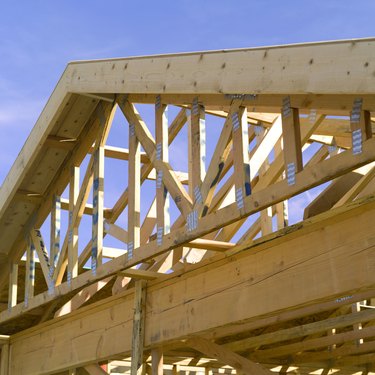Things You'll Need
Blueprints
Level
Tape measure
Pencil

Roof height can be a tricky thing to measure, thanks to the slope present in many roof shapes and the inability to take a straight, up and down reading. Roof height calculations can be made with the use of a mathematical formula that takes into account the width and slope of the roof and breaks the process down into one of geometry rather than construction practices. Roof height is an important factor when it comes to zoning new structures, worker safety and calculating the amount of roofing materials necessary for a given job.
Step 1
Inspect your blueprints, or check with your home builder to learn its pitch. If you do not have access to this information, proceed to Step 2 to find out the pitch on your own. If you already know the pitch, proceed to Step 3.
Video of the Day
Step 2
Enter the attic, and hold a level against the sloped ceiling wall, parallel to a truss. Mark a 12-inch span on the sloped ceiling with your pencil. Remove the level, and hold it against a rafter so it extends outward beneath your two pencil marks. Use the tape measure to record the distance between the level and the ceiling at the lower pencil mark, then again at the higher mark. The difference in these two measurements is equal to the amount of pitch in your roof. For example if the first measurement is 12 inches and the second is 18 inches, the pitch of your roof is 6 inches per foot, or 1/2.
Step 3
Measure the width of your home from one side to the other, or refer to your building plans for an accurate listing. Measure the amount of overhang at both ends of your roofing surface from the rooftop or a window within reach. Add these measurements to your overall structural width to determine the true width of your roof.
Step 4
Calculate the height of your roofing surface using the width and pitch. For example, if your roof is 20 feet wide and has a pitch of 1/2 (which means it rises 6 inches in height for every 1 foot of width), the height of your roofing surface from base to peak is 10 feet.
Tip
If you are able to mount the rooftop and have a helper, consider measuring your roof height the old fashioned way. Place the end of your extended length industrial tape measure onto the outermost edge of the roof, where it overhangs the edge of the structure below. Hold the end in place, and drop the tape measure to your partner below. Have your partner hold the tape measure at ground level, and record the distance. This is the height of your roof at its highest point. Perform the same process at the lowest point on your roof, and record this height as well. The resulting two numbers will determine the height range in your roofing surface.
Warning
Use extreme caution when on rooftops and when climbing ladders. Serious injury and death can occur.
Video of the Day